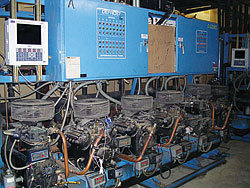Supermarket owners whose systems run on R-22 for medium- and low-temperature applications are looking at alternatives. If a decision is made not to replace the HCFC system with HFC-based equipment, the alternative is to retrofit.
Kentucky Conversion
Bigg's Supermarket converted two rack systems, one medium and one low temperature, in its Florence, Ky., facility. It converted from R-22 to One Shot® refrigerant (ASHRAE-designated HFC-422A), a product of ICOR International Inc. George Ronn, manager of EPA Compliance & System Controls for SuperValu Inc., the parent of Bigg's Supermarket, supplied ICOR with a preliminary assessment of the project as well as conclusions and excerpts of data recorded on SuperValu's energy management system.
The assessment indicated that the low-temperature rack ran primarily between 70 percent and 95 percent of capacity on R-22. On R-422A, the rack runs consistently between 60 percent and 90 percent with extended periods below 50 percent of capacity.

The conversion process, according to ICOR, involved changing out the power element of the expansion valve to one designed for R-404A. In the case of the Bigg's store, the control system was modified to what Ronn described as a floating suction algorithm that looks at the coldest-temperature case application on the rack. When conditions are favorable and when there is favorable subcooling off the roof, the suction target can be floated up to 4 pounds.
According to James Terry, manager of Engineering Services for ICOR, "When we look at jobs like this, we take the actual compressor displacement and determine the capacity at design conditions with R-22 and verify with the compressor manufacturer. We also verify the rack capacity from the rack manufacturer.
"We then change to the One Shot properties and recalculate," he continued. "Since this is a rack system with multiple compressors, there is a cumulative effect. Because the rack as a whole produces more capacity, it takes fewer compressors to achieve set point. Subsequently, the rack unloads and stays unloaded longer. Where it may have cycled four to five compressors to maintain set point, for example, three may suffice. The result is less energy consumed and smoother operation in conjunction with the control algorithm."
Ronn added, "One of the most satisfying pieces in the project is the improvement in capacity, and the reduction in the number of compressors needed to maintain the suction pressure target and product integrity. This will definitely translate into lower energy costs for compressor operation.
"We have experienced no problems with mineral oil return, migration, or separation in either of these two racks," he said.
"In fact, we had a significant amount of oil return to the racks from the evaporators after the conversion took place."
For more information, call 800-497-6805 or visit www.icorinternational.com.
Sidebar: New Developments At ICOR
ICOR International has announced several new developments. The company reported that it is now providing on-site refrigerant training for HVACR contractors nationwide. The program, called "The Move to HFCs," covers phaseouts, HFC refrigerant options, system conversion instructions, and troubleshooting.The company also reported that its distribution network for One Shot® (R-422A) has expanded to 950 locations.
Finally, Walter Cooper has been named regional business director for its East Coast region, and James McKinney has been named Midwest regional business director.
- Peter Powell
Publication date: 09/05/2005

Report Abusive Comment